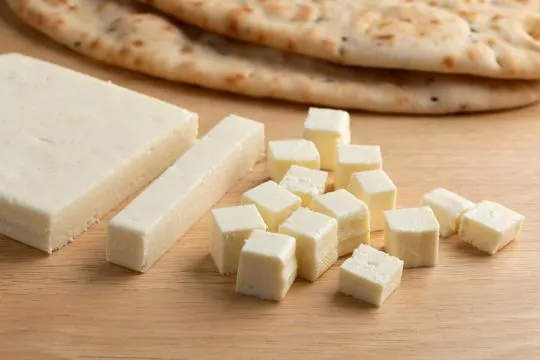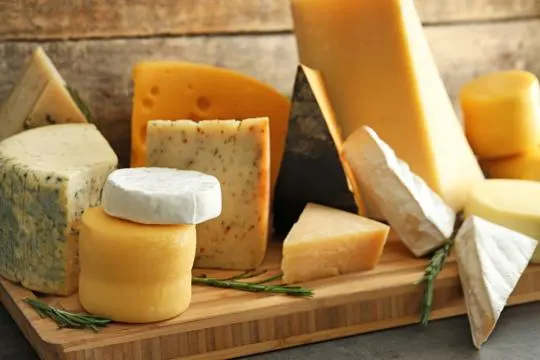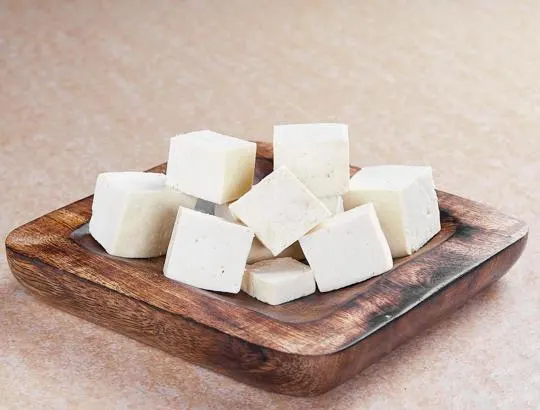Paneer and cheese sit on the grocery shelf like long-lost cousins. One’s from the heart of Indian cuisine, the other’s a globetrotter. We’ve all been there, staring blankly at them.
Ever find yourself in a midnight fridge raid, craving something cheesy? We do.
Paneer? It’s that soft, fresh cheese known for its crumbly texture. Squeaky on the teeth and mild in flavor. Cheese, oh boy, where do we start? It’s the MVP of comfort food.
Our nights with Netflix often include a cheese platter. Or a paneer tikka. Truth be told, we couldn’t live without them.
Each has its own charm. And secrets. We’re about to spill the beans.
What is Paneer?

Paneer is a beloved Indian cheese, made by curdling milk with lemon juice or vinegar – giving it a soft, crumbly texture.
It is different to other cheeses, as it doesn’t need aging or culturing.
Its mild taste and ability to take on flavors makes it a popular ingredient in many Indian dishes.
This cheese has a long history, believed to have come from the Persian region, and was introduced to India in the Mughal era.
It’s a staple in Indian cuisine, highly valued for its protein content and cooking versatility.
Paneer has a special characteristic – it doesn’t melt.
So it’s great for grilling or frying, and also crumbles nicely in soups and curries.
Plus, it’s packed with calcium, protein, and vitamins.
It’s a great choice for vegetarians and those looking for alternative proteins.
Yet, due to its high fat content, it’s best consumed in moderation, alongside a balanced diet.
What is Cheese?

Cheese – a cherished dairy product – is made by separating the solids from the liquid of curdled milk.
It needs a complex process of coagulation, draining, pressing, and aging to create its unique flavors and textures.
Cheese has various types and forms, each with its own specifics.
From Brie’s soft creaminess to Cheddar’s sharp crumbliness, there’s a cheese for every palate.
Its taste can be mild or pungent, depending on aging and production methods.
Cheese offers an array of flavors.
Some are sweet and nutty, while others are savory or tangy.
This diversity is because of differences in milk source (cow, sheep, or goat), ripening agents (bacteria or enzymes), and aging conditions.
Aside from its taste, cheese also provides various nutritional benefits.
It’s a great source of protein, calcium, vitamin B12, and phosphorus.
Plus, some cheeses have beneficial bacteria that help gut health.
Differences Between Paneer and Cheese

Paneer and cheese have many distinctions.
Paneer is an Indian cheese made with lemon juice or vinegar.
Regular cheese is made with rennet.
Paneer is crumbly and has a mild taste.
In contrast, cheese has various flavors and textures.
Paneer is mainly used in Indian cuisine, while cheese is used in different cuisines around the world.
Origin and Cultural Significance
Paneer and cheese are central to many culinary traditions.
Paneer, a staple in Indian cuisine, dates back to ancient times and is known for its unique texture and taste.
It is versatile and used in many regional dishes.
Cheese has a long history.
It has been made for thousands of years by ancient Egyptians, Greeks, and Romans, each culture adding its own flavors and techniques.
Paneer is made from cow’s milk and is created by using acidulants like lemon juice or vinegar to curdle the heated milk.
This produces a soft texture with a mild flavor.
Paneer is popular in traditional Indian dishes like saag paneer and palak paneer.
It is also suitable for both sweet and savory recipes.
Cheese is used in many dishes around the world.
From pizza topped with mozzarella to macaroni and cheese with cheddar, it adds flavor to recipes.
Feta, brie, and camembert are associated with certain countries or regions.
Ingredients and Production Process
Paneer and cheese are both dairy products, but they have distinct features.
Paneer is made by curdling milk with lemon juice or vinegar.
Whereas, cheese is produced by curdling milk with bacterial cultures and enzymes.
These dissimilarities affect the texture, taste, and culinary uses of these two versatile dairy products.
Paneer is used extensively in Indian cooking.
For instance, palak paneer and paneer tikka.
It has a fresh, creamy texture and a mild flavor, and is quickly prepared at home.
Milk is strained to separate the whey, thus producing a soft and crumbly cheese that can be cut into cubes or grated.
Cheese is quite different.
It has a great variety of types and flavors due to its complex production process.
Bacterial cultures and enzymes are added to the milk to make it coagulate.
The coagulated milk is then cut into curds and separated from the whey.
These curds are pressed, aged, and sometimes smoked to create different flavors and textures.
From cheddar to brie to gouda, there is an extensive range of cheeses.
This diversity allows for numerous culinary possibilities as cheese can be employed for cooking, snacking, or even as a stand-alone treat on a cheese platter.
To summarise, Paneer and cheese have unique characteristics that make them suitable for various culinary applications across different cultures around the world.
Texture and Consistency
Paneer and cheese are different in texture and consistency.
Paneer is crumbly and firm, whereas cheese can range from soft and smooth to semi-hard or hard.
Paneer is made from milk curdled with lemon juice or vinegar, creating a granular texture that holds its shape when cooked.
Cheese has a wider range of textures due to production methods and aging.
Soft cheese like brie and camembert are creamy and smooth, while semi-hard cheeses like cheddar or gouda have a slight crumbliness and elasticity.
Hard cheeses like Parmesan or aged cheddar are dense and brittle.
Paneer has a solid consistency throughout, but cheese can vary within the same block due to aging.
Both paneer and cheese offer unique culinary experiences.
Whether you prefer the crumbly satisfaction of paneer or the variety of textures in different types of cheese.
Flavor Profile and Taste
Paneer and cheese might appear similar, but they have dissimilar tastes and flavor profiles.
Paneer, an Indian cheese type, has a mild and milky flavor with a slight tanginess.
On the other hand, cheese has many flavors, from mild and creamy to sharp and pungent.
The flavor of cheese is based on various factors such as the type of milk, aging process, and adding of other ingredients like herbs or spices.
Regarding texture, paneer is firm yet crumbly.
It is great for grilling or stir-frying as its smooth consistency absorbs flavor well when marinated or cooked with spices.
Cheese texture can vary depending on its type.
Soft cheeses, such as brie or camembert, have a creamy texture that melts in your mouth.
Hard cheeses, like cheddar or parmesan, have a dense and crumbly texture.
Taste-wise, paneer has a gentle and sweet flavor that tastes great with Indian spices like palak paneer or paneer tikka.
Cheese has a wide range of flavors due to its different types.
From the mild taste of mozzarella to the boldness of blue cheese or the nuttiness of Swiss cheese, each kind has its own characteristics that appeal to many preferences.
In conclusion, though both paneer and cheese are created from milk, their flavor profiles and tastes are distinct.
Paneer has a subtle milky taste with a touch of tartness and a firm yet crumbly texture.
In comparison, cheese has a variety of flavors from mild to pungent and its texture depends on its type.
Recognizing the differences between these two dairy products can aid you in making educated decisions when cooking or consuming them.
Nutritional Composition
Comparing paneer and cheese, one thing stands out – their nutritional content.
Paneer is known for its high protein and low fat.
Cheese comes in different types and offers different values.
Both are great for calcium.
Paneer is a vegetarian option due to its protein-rich nature.
Knowing the nutrition of each can help you make informed choices for your health.
When deciding between paneer and cheese, think of their nutritional contributions to make the best choice.
Similarities Between Paneer and Cheese

Paneer and cheese may differ, yet they possess some similarities.
Firstly, they’re both formulated from milk, with solids (curds) being separated from liquid (whey) via an acid or enzyme.
Additionally, they can be used in many cuisines, be it savory dishes or desserts.
Not to mention, their protein, calcium, and other essential nutrient contents are splendid.
Despite their dissimilarities in taste and texture, these common traits make them highly useful in enhancing recipes.
Furthermore, a key contrast between paneer and cheese is the production process.
Generally, paneer is made by heating milk with a sour agent like lemon juice or vinegar.
The strained result is soft and crumbly.
On the other hand, cheese involves a more complex method with variations based on the type being created.
This world of cheeses is thanks to different cultures and techniques.
Lastly, another major distinction is their respective roots.
Paneer originated in South Asia, particularly India and Pakistan, and has been part of their traditional dishes for centuries.
Cheese, however, has a long history globally, having existed for thousands of years in various regions.
In conclusion, while there are resemblances between paneer and cheese, their unique characteristics bring about distinct flavors and textures.
Therefore, it all comes down to one’s personal taste and cultural inclinations when deciding which one to prefer.
Varieties of Paneer and Cheese
Paneer and cheese – two popular dairy products, each with its own distinct characteristics and flavor.
Milk is the source for both, yet the processes for their production are different, resulting in unique textures and tastes.
Paneer is a traditional Indian cheese, soft and crumbly.
It’s made by curdling milk with lemon juice or vinegar – separating curds from whey.
The curds are then strained and pressed for excess moisture.
This cheese is often used in Indian dishes, giving them a creamy richness.
Cheese is a broad term, encompassing various types and varieties from around the world.
Cow’s milk, goat’s milk, sheep’s milk, even buffalo’s milk – all can make different types of cheese.
The production process involves adding rennet to the milk, which coagulates it.
Curds are sliced, heated, pressed and aged for different lengths of time, to develop unique flavors and textures.
Feta, cheddar, mozzarella, brie, camembert, blue cheese – the list of varieties is endless.
Each kind has its own taste profile and purpose in cooking.
From sharp and tangy to mild and creamy, cheese is a great addition to any cuisine.
While paneer is mostly used in Indian dishes, cheese is enjoyed worldwide.
Pizzas, sandwiches, wine tastings – you name it.
Cheese is appreciated everywhere.
Culinary Uses and Recipes
Paneer and cheese may look alike, yet have different culinary purposes and recipes.
Paneer is an Indian cheese made of coagulated milk.
It has a subtle flavor and a solid texture, perfect for grilling and frying.
Cheese, however, comes in many kinds such as cheddar, mozzarella, and feta.
Each type has its own flavor and melting properties.
Cheese is often used in sandwiches, pizzas, and gratins because of its meltability and full-bodied flavor.
Both paneer and cheese can add a delightful touch to any dish.
Conclusion
Paneer is a soft, creamy cheese often used in Indian cuisine.
It has a crumbly texture and mild taste that is achieved by curdling milk with lemon juice or vinegar.
In contrast, cheese encompasses a wide variety of dairy products, each with its own characteristics due to the ingredients, processes, and aging techniques used.
Notably, cheese-making involves the use of rennet which contributes to its elastic texture, while paneer does not.
Additionally, while paneer can be made at home, cheese production requires more complex methods like pasteurization and culturing of bacteria.
Nutritionally, the two differ due to variations in processing and added ingredients.
Paneer is high in protein and calcium, making it ideal for vegetarians, while certain types of cheese may contain higher levels of fat.
Ultimately, paneer and cheese offer distinct culinary experiences that appeal to different tastes.

Leave a comment